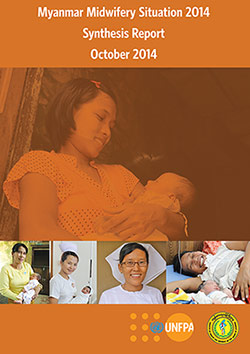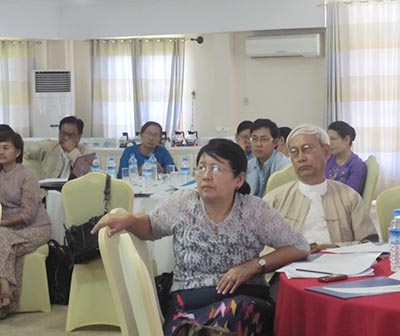Midwives across Myanmar do more than just deliver babies. They are the unsung heroes of improving the quality of services to pregnant women, new mothers and newborns, according to the findings of a UNFPA supported report “Myanmar Midwifery Situation 2014,” which was revealed on 15 October 2014 at a launching ceremony held in Nay Pyi Taw, the nation’s capital.
The Myanmar country midwifery report, also referred to as a country synthesis paper, is the brainchild of answers from a questionnaire sent to 75 countries for the preparation of the second ever State of the World Midwifery report. The report, issues in 2014, includes outcomes from key discussions of a stakeholder workshop held in the beginning of the year. The report outlines the need to further boost Myanmar’s midwifery and basic reproductive health care services, especially in the rural areas of the country where approximately 70% of the population resides.
H.E. Dr. Thein Thein Htay, Deputy Minister of Health and Ms. Janet Jackson, UNFPA Myanmar Representative jointly launched the Myanmar version of the State of the World Myanmar 2014 report entitled “A Universal Pathway. A Woman’s Right to Health" on 15th October 2014.
“Myanmar has an enabling national health policy and national health workforce strategic plan in place which creates an environment that supports for an effective midwifery education, regulation and association development. I will admit that there is room for improvement to allow for the development of higher levels of midwifery skills in order to attain better quality of Sexual, Reproductive Health, Maternal, Newborn Health services, including professional development and opening of career pathways for midwives,” said H.E. Dr. Thein Thein Htay in her opening address.

Ms. Janet Jackson said at the opening of the launch of the country's first ever State of Midwifery report (SoWMy) that “Our analysis would suggest that an estimated 7000 more midwives are needed in Myanmar to meet the WHO standard of 2.3 health workers per 1000 population.” She also highlighted that midwives are a vital part of improving Myanmar’s health care system and that the need for midwives is as important as ever.” They are contributing ever day to reducing maternal mortality.” Despite the country seeing a decline in mortality rates over the past two decades, the number still remains high for the region, with deaths being most common in home-delivery babies in rural areas. The report points out that there are still significant gaps in coverage of maternal health care as the proportion of deliveries of skilled birth attendants is only 64%, though gradually improving from 58% in 2005.
Ms. Jackson stressed that UNFPA is combining efforts with the Myanmar Nurse and Midwife Association and the Ministry of Health to tackle the country’s need for more midwives through “continuous training to expand their existing skill-sets and scope of work, including deployment of midwives in far to reach and rural areas.” In Myanmar there are currently only 1.3 health workers for every 1,000 people - less than the 2.3 standard advised by the WHO. “On average one midwife has to cover 5 to 10 villages often having to travel long distances between villages. Only about half of midwives eligible to practice, are employed. However for them to stay as practicing midwives, changes are needed so that midwifery has its own incentives as a stand-alone profession and is more than simply an entry point to a career in nursing,” said Ms. Jackson.

Participants at the two-day event also included experts from the Myanmar Department of Health, the Ministry of Health, Myanmar Medical Association (MMA), Myanmar Midwife and Child Welfare Associated (MMCWA),Myanmar Nurse Midwife Association (MNMA), Myanmar Nurse Midwife Council (MNMC), including representatives from other UN agencies and international development partners.
The key recommendations derived from the two day event highlighted that: Midwifery should be an independent profession apart from Nursing, to improve and elevate the levels of midwifery education and career opportunities and to broaden the skill set and mandate of the midwife, and that more midwives are employed in line with international recommended practice. Myanmar is in the process of aligning itself to ASEAN standards.
The State of the World’s Midwifery report 2014 takes its inspiration from the United Nations Secretary General, Ban Ki-moon’s “Every Woman, Every Child” initiative, launched in September, in which he calls for action to do everything to achieve the Millennium Development Goals (MDGs) by 2015. The initiative also aims to work towards the development and adoption of a post-2015 Sustainable Development Agenda, based on the principle of universality. The first SoWMy report was launched in 2011.


